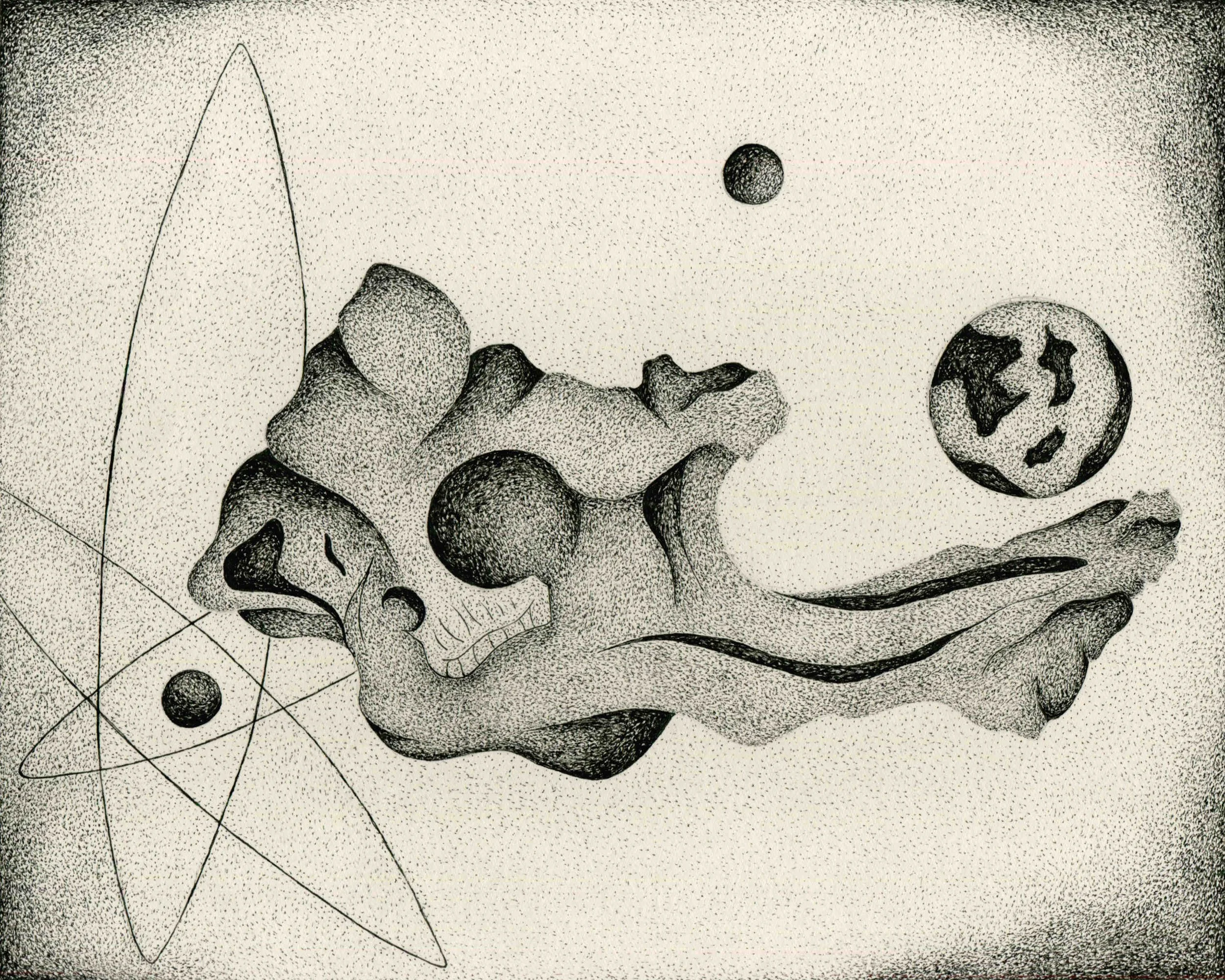The Weight of Knowing: The Atlas Vertebra as a Bridge Between Body, Mind, and Universe
Pen and ink contemporary fine art by Doug Ashby
The atlas vertebra was first introduced to me by a dear friend who is a chiropractor. He specializes solely in this fascinating structure, which sits at the top of the spine just below the skull. It takes its name from the gentle Titan Atlas, who was punished for insurrection and condemned to bear the weight of the heavens upon his shoulders. In Greek, Atlas translates to endure.
However, it was not always the first vertebra that carried this illuminating name. Until the Renaissance, anatomists identified the C7—the vertebra at the shoulders—as Atlas. It was during that period that the term shifted upward to the C1, symbolizing a profound change in human belief: that our burden had moved from the physical to the mental. Humanity’s weight was no longer carried on the shoulders but within the mind.
The artwork above was created in direct response to my friend’s explanation of the atlas vertebra. Through research, I became intrigued not only by the metaphorical and philosophical aspects of this bone but also by its physical role within the spine, which serves as a conduit for the entire body. I began to wonder if the atlas vertebra could serve as a metaphor for the human condition itself. Since the Renaissance and Enlightenment, our mental models have come to bear the weight of our growing awareness. That weight, I believe, is our need to reconsider our place within, not separate from, the larger environment.
This is not an argument against the rise of individualism. The shift from collective conformity toward individual thought brought enormous progress. From the seventeenth to nineteenth centuries, new mental models, human rights, and scientific discoveries flourished. We began to challenge authoritarian structures and claim personal agency. Our expanding awareness of ourselves and our place in the cosmos led to deep introspection, lifting many from mere survival toward creative potential.
Yet self-awareness carries a cost. It can liberate, but it can also isolate. At this point in my own life, I’m aware of both potentials and pitfalls. There is comfort in what lies behind me, in my years as an art educator, but that safety also carries weight. The “sunk cost” of my past and the unknowns of pursuing art and writing full-time both rest heavily on my own atlas. The burden is not just personal; it is societal. We are told to chase our dreams without hesitation, yet the realities of responsibility demand that we move with care.
As an artist, I am continually drawn to reflections of form and to the way the smallest subatomic structures mirror the largest cosmic ones. In this piece, I depict the electron, the fundamental building block of all matter, alongside planetary and anatomical forms. What fascinates me is how the structure of an electron resembles the orbits of celestial bodies, suggesting an underlying unity between the micro and macro, between the body and the cosmos. Within this artwork, the atlas vertebra becomes a symbolic gateway, a bridge where physical structure meets spiritual awareness and where we begin to understand that we are not separate, but profoundly connected.
Burdens are part of being human. We all carry them, in varying forms and intensities. For me, the realization that I must now fully commit to life as an artist feels light. The truth has settled in. For years, I resisted it, and that resistance was the heavier weight. Societal expectations remain a pressure, but they no longer define the burden itself. As I age, I find greater humility and resilience in this awareness. Like the electron, we are small yet essential parts of a greater whole. I find grace in that understanding, accepting that I am but one necessary cog in the vast cosmic order.
Even the smallest parts of the whole matter. The shift from Greek mythology to Renaissance rationalism brought scientific clarity but also an unintended separation—from one another, from community, and from the spirit that once nourished human existence. Through my artwork and writing, I aim to reunite these two ways of knowing, mythic and scientific, into a unified vision. To see science as sacred and structure as spiritual, without distinction between the two.
Connection—to each other, to community, and to nature—is what sustains life. It nourishes not only us in the present but those who will follow. The atlas is therefore not merely a symbol of burden but one of balance.
In this artwork, that balance is visualized. The smallest parts of the whole interact with the largest, and between them, a metaphorical conduit—the atlas—bridges the gap. Awareness brings burdens, but if we move through them with grace, we recognize that we are both carriers and participants in a greater whole. When cared for, this whole provides abundance that serves all. The atlas vertebra does not merely bear consciousness; it connects it.
As always, I hope you enjoy both the art and the writing. This original artwork, Atlas Vertebra, is available for purchase (8” x 10”, ink on paper, $440). If you’re interested, please reach out via my contact page. I also welcome deeper conversations, so feel free to leave a comment and I promise I’ll respond.
—Doug
